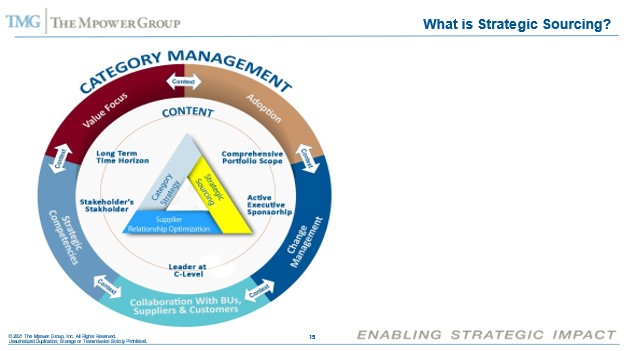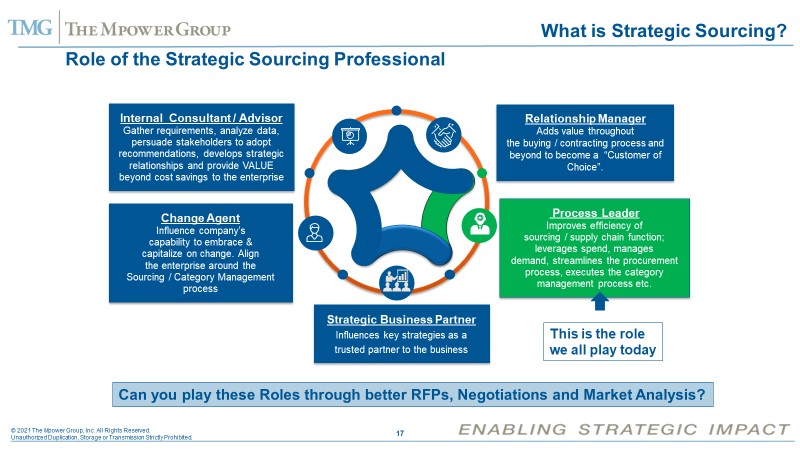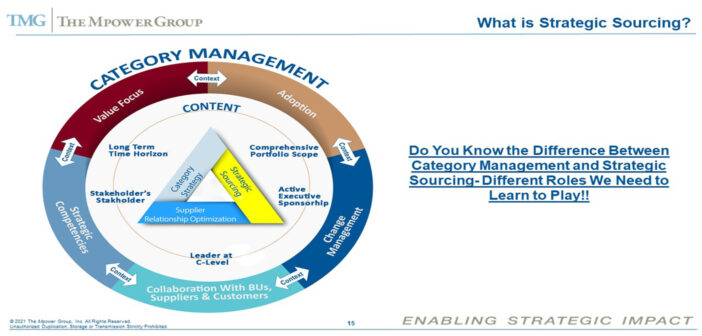Many of you continue to ask us to focus on the difference between Category Management (CM) and Strategic Sourcing (SS). The first clarification we would make is that CM is the next level of maturity from SS so it’s not a question of one vs. another but rather building on SS. This is an important point to understand so that we don’t start thinking of one replacing the other.
Here is a definition of CM that we use in our workshops that you might find useful:
Framework and set of practices used to optimally manage supply categories to meet business objectives. This framework sits above and guides the content and sequencing of lower-level methodologies like Strategic Sourcing and Supplier Relationship Optimization to satisfy category and business objectives. A category is a grouping of goods or services that have a similar supply and usage characteristics to meet business objectives.
The model above has proved very effective in having this dialog with senior executives looking to transform their organizations to the next level of maturity. Let me just pick a few of the points we make by focusing on the outer band of the model.
Clearly, CM has a much bigger focus on the context than SS. Here is a simple definition from Merriam Webster of context: “the situation in which something happens : the group of conditions that exist where and when something happens”. And to influence context, TMG has identified the following factors.
Value Focus: While the focus on TCO in SS is not forsaken, it is balanced out by a vigorous emphasis on Stakeholder Value Drivers. And as we have pointed out before, this emphasis does not happen without a concerted effort and significant changes in elements like processes, metrics etc. etc. etc.
Adoption: The challenge of Adoption magnifies exponentially in CM because contextual changes are that much harder for organizations to adopt. For example, the changes required by CM in decisions and behaviors by our Stakeholders require an effort on Adoption. The changes in processes, metrics etc. mentioned above suggest the same effort.
Change Management: Yes, we’re back with Change Management and don’t think we need to say anymore on why this is critical???
Collaboration: CM does require a fundamental shift in how we look at relationships both internally and externally. The level of collaboration required to be successful at CM is a step change in how we approach establishing and optimizing these relationships. And the biggest challenge in changing attitudes about and towards suppliers is executive management. Without successfully changing these attitudes, significant value is left on the table and leverage is sacrificed to our competitors.
Strategic Competencies: And of course, none of the above is possible unless you make sure that your people have the Strategic Competencies necessary. Getting better at RFPs or negotiations will do very little to impact any of the above factors? Just take a look at the different roles required to be successful at CM:

Every single one of these roles are important and other than the Process Leader role, ALL the others require strategic competencies. You can hire us (or others 😊) to play those roles for you on your journey to CM or you can hire us (or other 😊) to develop those competencies in your people. But without those roles being fulfilled, your journey to CM will definitely be bumpy and perhaps even reach a dead end.


